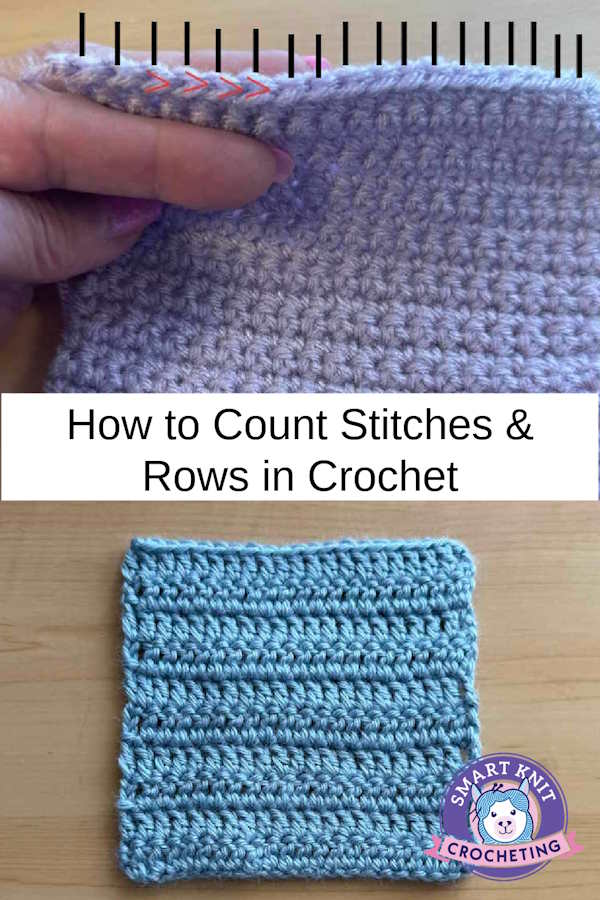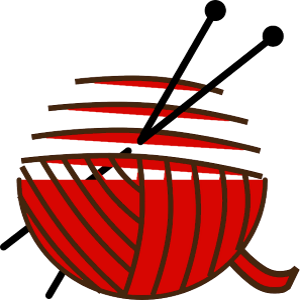- Home
- How to Crochet
- How to Count Crochet Stitches
How to Count Crochet Stitches and Rows for Beginners
How to Count Crochet Stitches, by Janice
Counting stitches in crochet is essential if you want your project to take the intended shape and maintain a consistent design.
If we forget to count, a beginning-level project, such as a scarf or a blanket, may end up wide at one end and narrow at the other. Inadvertently adding or subtracting stitches causes uneven edges, which can easily be remedied by counting.
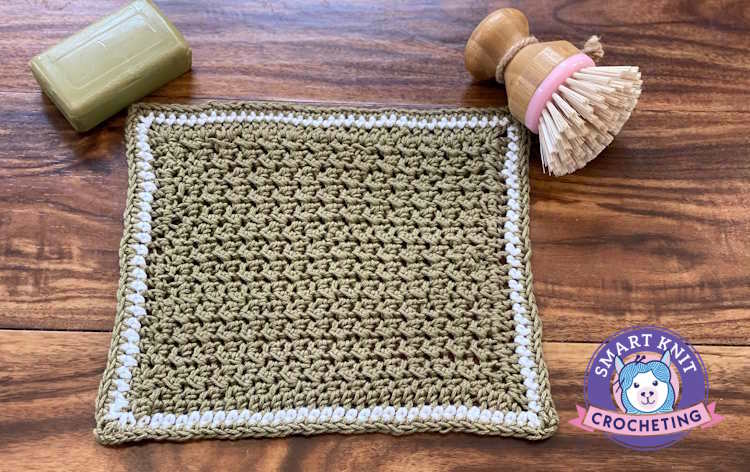 How to Count Crochet Stitches
How to Count Crochet StitchesThese lopsided, oversized, or too-small projects creep up on you before you realize it, and the only thing to do is to rip out (frog) to the location where the increase or decrease occurred. No one likes to do that.
Therefore, counting saves time and aggravation in the long run and makes your projects look more professional.
Before you know it, counting stitches and rows becomes second nature, and you won't need to think about it. In the beginning, however, stopping and counting every row is advisable.
How to Count Crochet Stitches Requires One to Recognize Crochet Stitches
Before we can count, we must first know what the stitches look like. Don't worry; there are only a few basic crochet stitches: Single, Half Double, Double, and Triple Crochet Stitches.
These are the US terms used for these stitches. I am using American terms for this article, but you should know that the names differ in the UK.
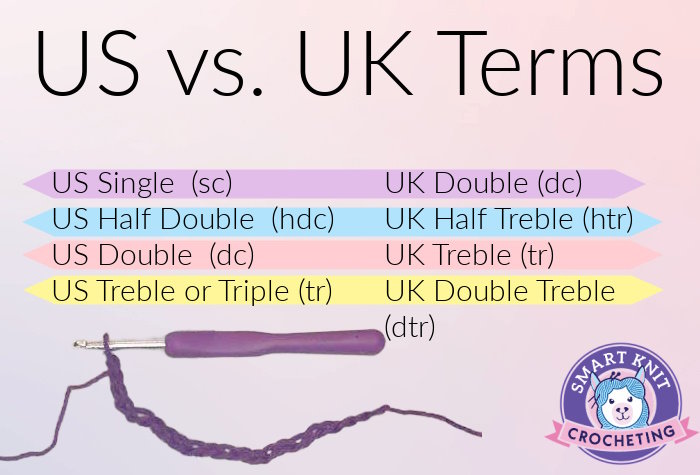
US: Single Crochet UK: Double Crochet
US: Half Double UK: Half Treble
US Double UK: Treble
US: Treble UK: Double Treble
Basic Crochet Stitches
The basic stitches primarily differ in height, and the number of yarn overs and loop pulls involved in creating them.
Each stitch affects the density, texture, and appearance of the fabric you're crocheting, so different patterns will call for different stitches depending on the desired result. How to count crochet stitches requires a good understanding of individual stitches. Here's a brief look at how they vary:
Chain Stitch (ch)
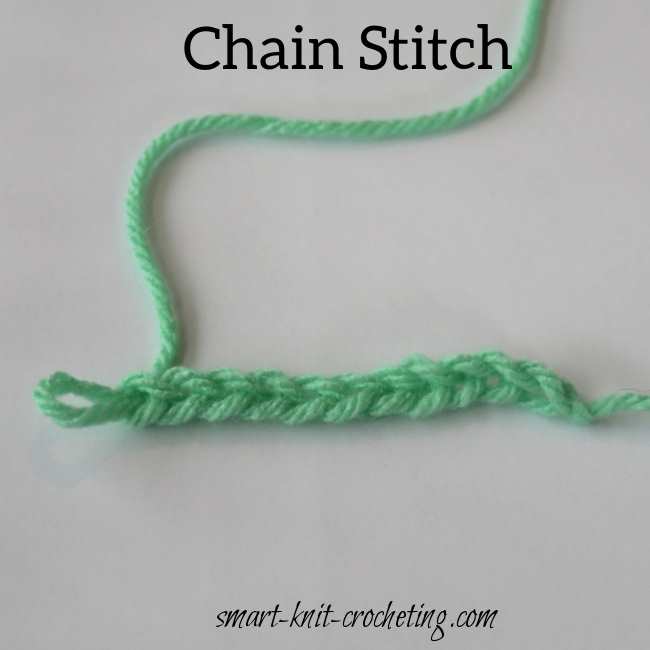 Crochet Chain Stitch
Crochet Chain StitchChain Stitch (ch): This is the simplest and most fundamental crochet stitch. It involves looping the yarn over the crochet hook and pulling this loop through the one already on your hook.
US: Single Crochet (sc)
UK: Double Crochet
Single Crochet (sc): One step up from the chain stitch in height. To create a single crochet, you insert the hook into the stitch, yarn over the hook, pull through the stitch, yarn over again, and then pull through both loops on your hook.
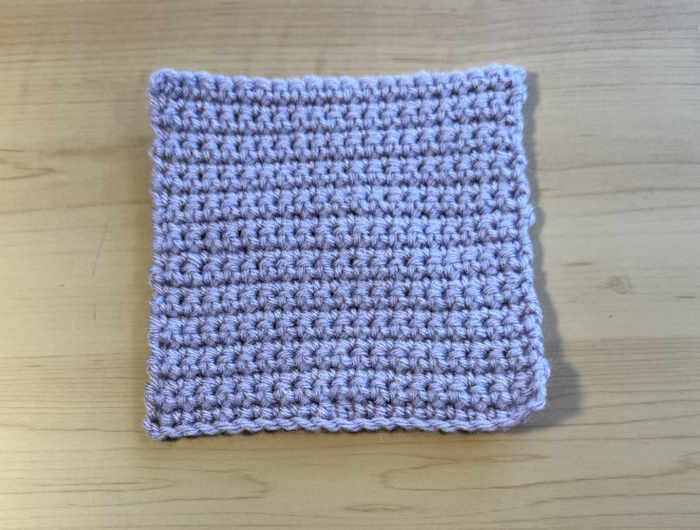 Single Crochet
Single CrochetUS: Half Double Crochet (hdc)
UK: Half Treble Crochet
Half-Double Crochet (hdc): This stitch is midway between a single and double crochet. For a half-double crochet, yarn over the hook, insert the hook into the stitch, yarn over again, and pull through the stitch, yarn over again, and pull through all three loops on your hook.
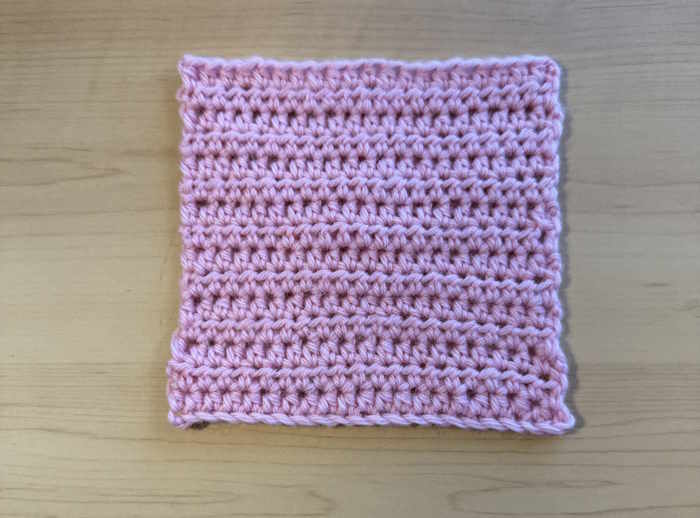 Half Double Crochet
Half Double CrochetUS: Double Crochet (dc)
UK: Treble Crochet
Double Crochet (dc): This is taller than the single and half-double crochet.
To create a double crochet, yarn over the hook, insert it into the stitch, yarn over again and pull through the stitch (you now have three loops on your hook), yarn over and pull through the first two loops, then yarn over again and pull through the remaining two loops.
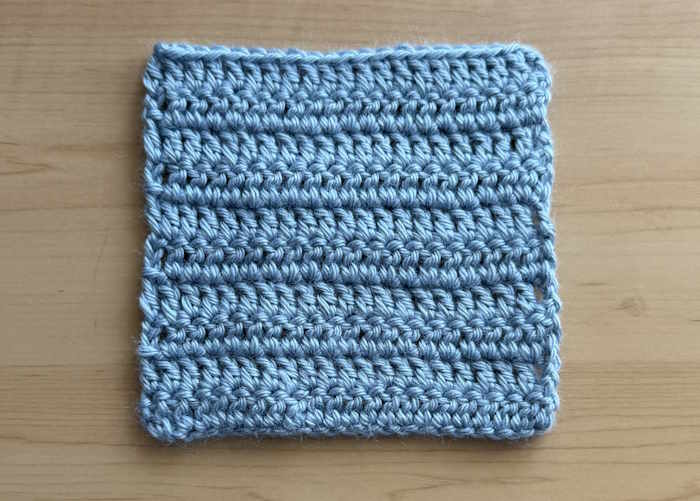 Double Crochet
Double CrochetUS: Treble Crochet /Triple Crochet (tr)
UK: Double Treble Crochet
Treble Crochet / Triple Crochet (tr): This stitch is taller than the double crochet. It involves two yarnovers before inserting the hook into the stitch, then a series of yarnovers and pulling through two loops until you’ve worked off all the loops on the hook.
We must first be able to identify the stitch and row before we can begin counting. Understanding the shape of the stitch may help you identify and count them.
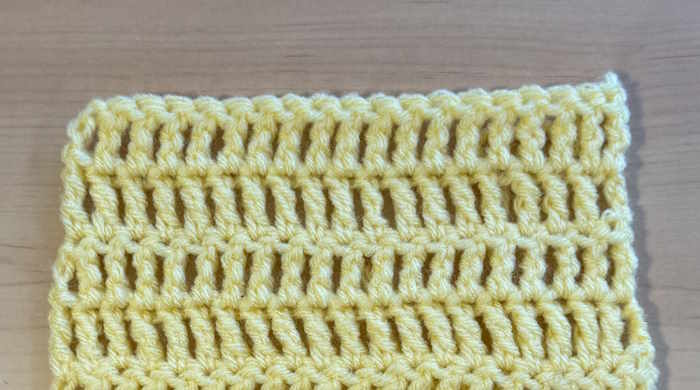 Treble Crochet
Treble CrochetHow to Count Crochet Stitches
There are two ways you can count your crochet stitches.
- Count the little Vs at the top of the row.
- Count the stitch posts.
Some stitches are more straightforward to count than others. The taller the stitch, the easier they are to see and count.
These taller stitches include the double and treble crochet stitches. For these, it's much easier to count the post of the stitch.
The single and half double crochet stitches are tighter and smaller, so counting the little v's on the top of the row might be more manageable.
Counting Chain Stitches
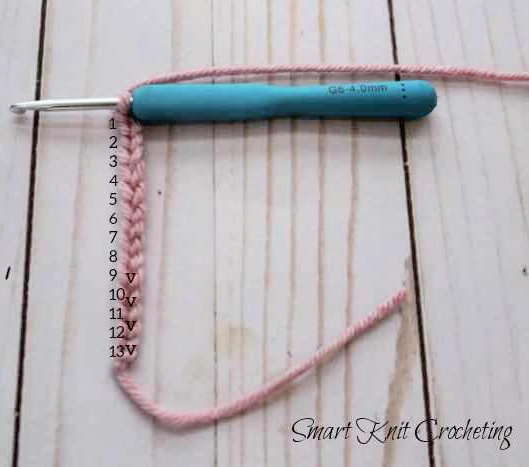
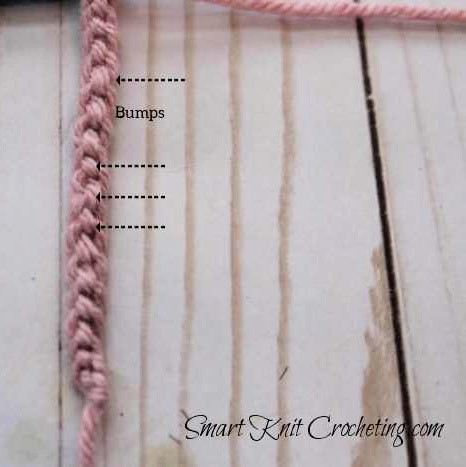
While the beginning or foundation chain is not added to your row count, making the correct number of chains is vital when beginning a project. There are two ways to do this.
- Locate the little V's and count each V. Do not count the loop of yarn on your hook or the slip knot.
- Turn the chain over and locate the little horizontal bumps. Count the bumps, but do not count the loop of yarn on your hook or the slip knot.
How to Count Crochet Stitches: Single Crochet
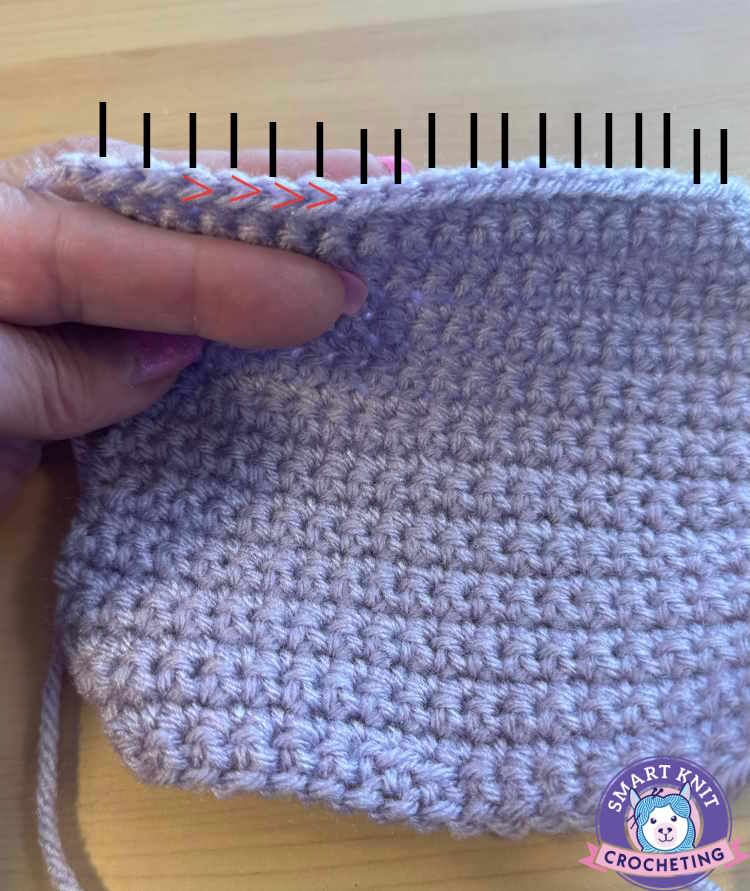
You work in rows back and forth, turning your work at the end of the row. This means that one row of stitches will be on the right side, and the next will be on the wrong side. When working in the round, you don't turn your work, so all stitches will be on the right side and look similar. (More about counting stitches in the round below).
When making single crochet stitches, the first chain at the beginning of the row does not count as a stitch, so you will count the single crochet stitches across the row.
Beginner crocheters may count the little v's at the top of the row because they are easier to see. If you want to count the posts, the right side is usually easier to see the little legs that make up the post.
If you finished a wrong side row and need to count, turn the work over to the other or front side. In my opinion, single crochet are the hardest stitches to count.
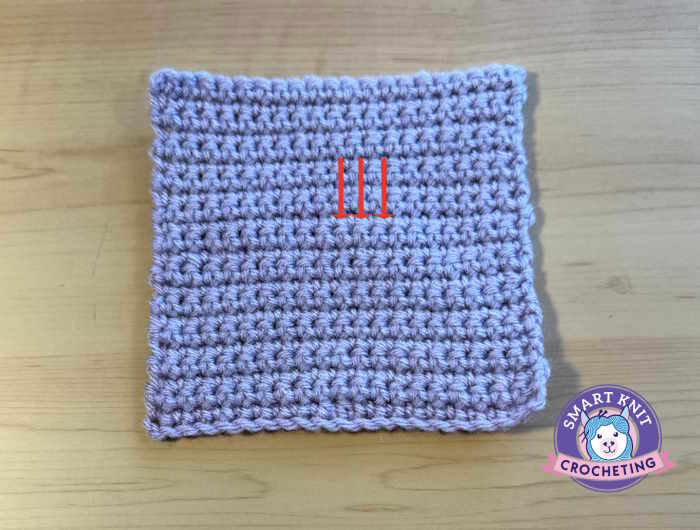
HINT: Crochet Stitches have two little legs with varing horizontal bars.
The single crochet stitch has two little legs with one horizontal bar. It reminds me a little of the Pi symbol. π
Counting Half Double Crochet Stitches
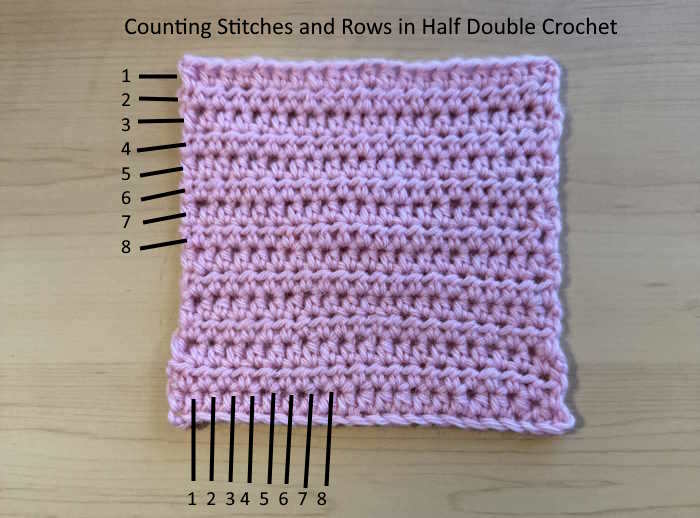
Again, the easiest way to count is to identify the little V's at the top of the row and count each V. Half double crochet stitches are challenging but not as hard as single crochet.
Each stitch has a vertical bar with a horizontal loop at the top. Count the vertical bars. If you can see individual stitches, stretch the fabric slightly horizontally, and you should be able to see them better.
Counting Double and Treble Stitches
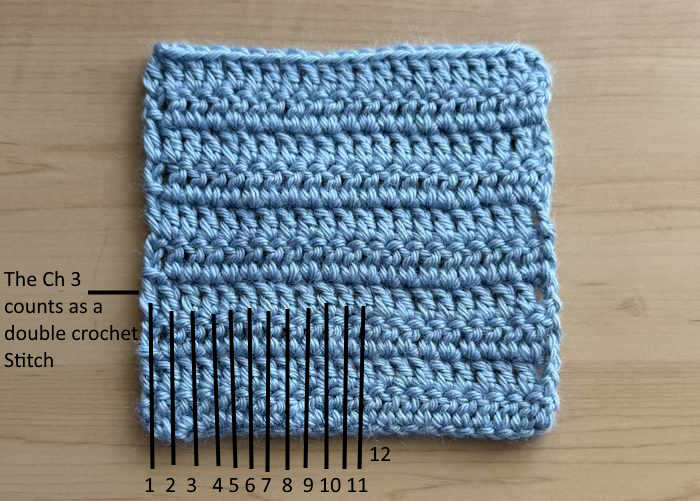
Counting double, treble, and taller stitches usually does not pose a problem, even for beginners.
Their posts are tall, and there is some space between each post. Count the posts. Again, if you prefer, you can also count the little V's at the top of the row.
How to Count Crochet Rows
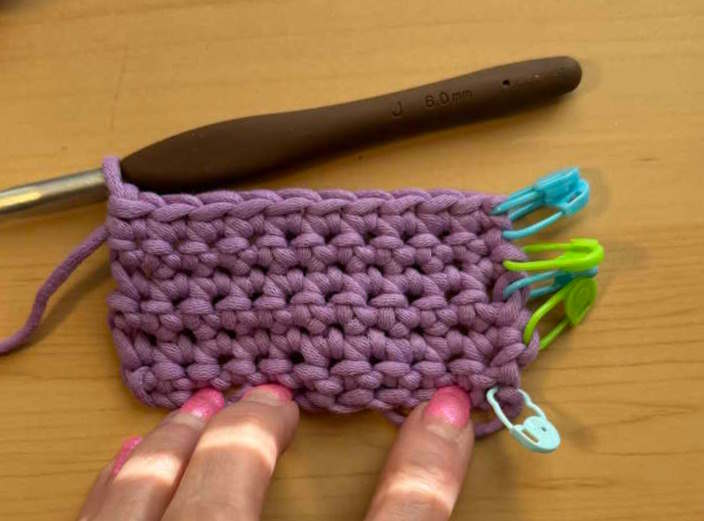 Stitch markers are used to identify rows in this single crochet swatch. The swatch consists of six rows of single crochet.
Stitch markers are used to identify rows in this single crochet swatch. The swatch consists of six rows of single crochet.When working from a pattern, the designer may tell you to work a certain number of rows or continue working until your piece measures a certain length (in inches and centimeters). Either way, it is essential to know how to count rows.
When working in rows, you turn your work at the end of each row. After turning your work, you will see the back side of the stitches.
Each row will look a little different because one row will be the right side, and the next row will be the wrong side. This makes counting rows a little easier. There are other tricks you can use to count the rows.
1. Row counters
A row counter is a small tool that keeps count of your rows for you, so you don't need to keep that number in your head. There are different types, but they all work similarly.
When you come to the end of a row, you click, push a button, or turn a knob, and the following number appears. You can also do this as tally marks on a slip of paper if you prefer.
Either way, counting as you go saves time, especially when working on a large project.
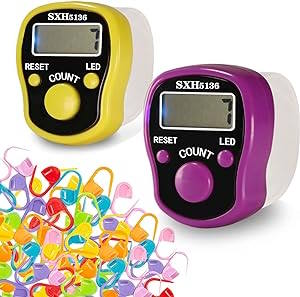 Stitch Markers and Row Counters are useful tools to have nearby.
Stitch Markers and Row Counters are useful tools to have nearby.2. Stitch Markers:
Stitch markers come in various colors and shapes, but all open up to allow you to pin them to your work. There are also stitch markers that look like little rings with no openings.
This type of stitch marker is for knitting, where the ring is placed on the knitting needle. It is useless for crochet. You can use stitch markers in some different ways.
As the name implies, you can use them to count off your stitches, especially if you are working within a pattern repeat. You can also use them to count off a certain number of stitches if you are working with a large number of stitches, say a blanket.
Placing a stitch marker every 20 chains will save you the time to count the entire number of chains before you begin to crochet. Finally, you can add a stitch marker to the end of every row. To count the rows you have made, count the stitch markers.
3. Tally Marks:
This is probably the easiest and most low-tech way to keep track of the rows. Add a tally mark at the end of each row.
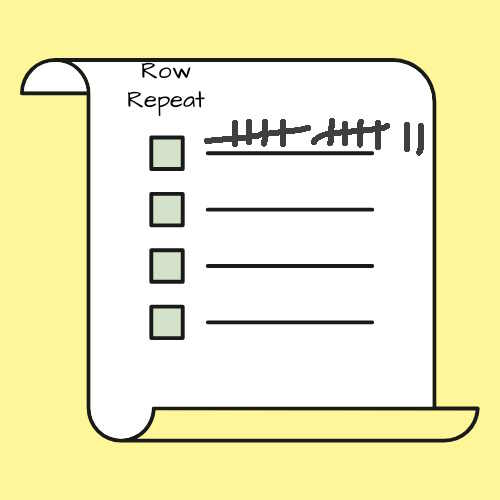
4. Front and Back of Stitches:
If you can recognize the front side row more quickly than the back side row, count all the front side rows and multiply by two for an accurate row count.
5. Count Out Loud:
This may seem odd, but counting aloud keeps you on track and can put you into a meditative state where you relax, and your counting becomes almost automatic.
6. Breaks:
Yes, take a break. Some crocheters spend so much time crocheting that they lose time, let alone stitches. Take a break, stretch, massage your hands, and fix yourself a cup of tea.
How to Count Crochet Stitches and Rows in the Round
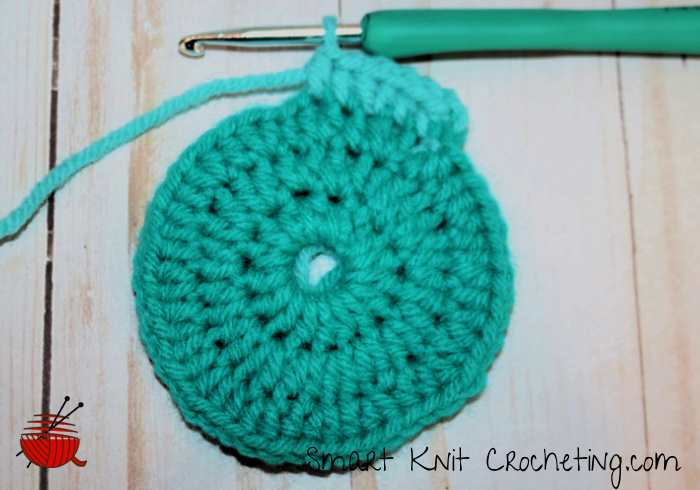
Counting stitches and rows in the round is similar to rows with just a few differences.
The same principles apply to identifying stitches and counting the posts or the v's at the top of the circle or round. The principle of how many chains to make at the beginning of the round is also the same unless your pattern tells you otherwise.
There are a few differences to keep in mind. You will use the stitch indicated in the pattern (e.g., double crochet) when making a circle.
When you reach the end of the round, you will either place a stitch marker to indicate where you began if you are crocheting a spiral or use a slip stitch to join at the top of the chain. The slip stitch is not a stitch.
The next row in a round requires you to increase stitches so the circle lays flat. This is where counting is so important. You will count each stitch (e.g., double crochet you make, including all the increases until you return to the origin of the round.
You will know you have arrived because you will see the chain three that began the round.
Most good patterns will tell you exactly how many stitches you should have. Counting those stitches is crucial to ensure your count agrees with the designer's. Suppose they don't figure out where you went wrong.
Did you make the increases where indicated? Did you accidentally work into the slip stitch at the end of round one? This will give you an extra stitch.
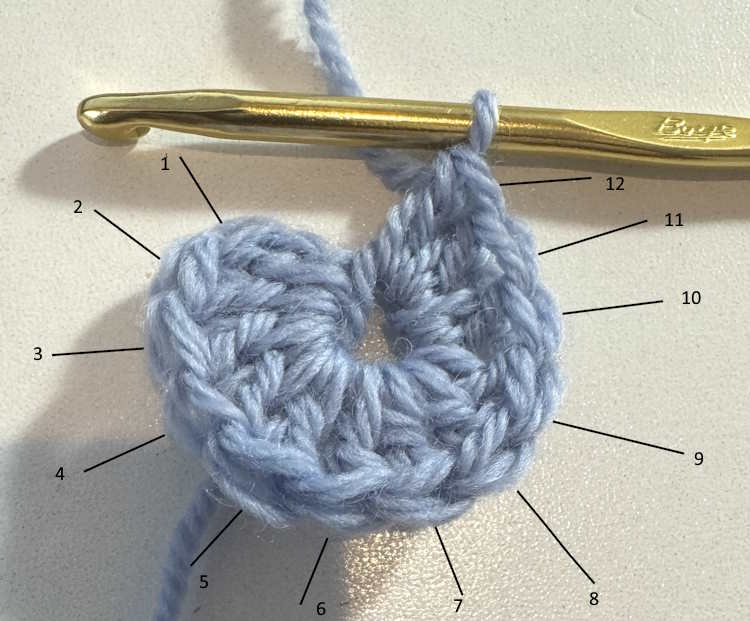 Counting stitches in the round can be done by counting individual posts or the little v's on the edge of the round. This is a round of double crochet stitches.
Counting stitches in the round can be done by counting individual posts or the little v's on the edge of the round. This is a round of double crochet stitches.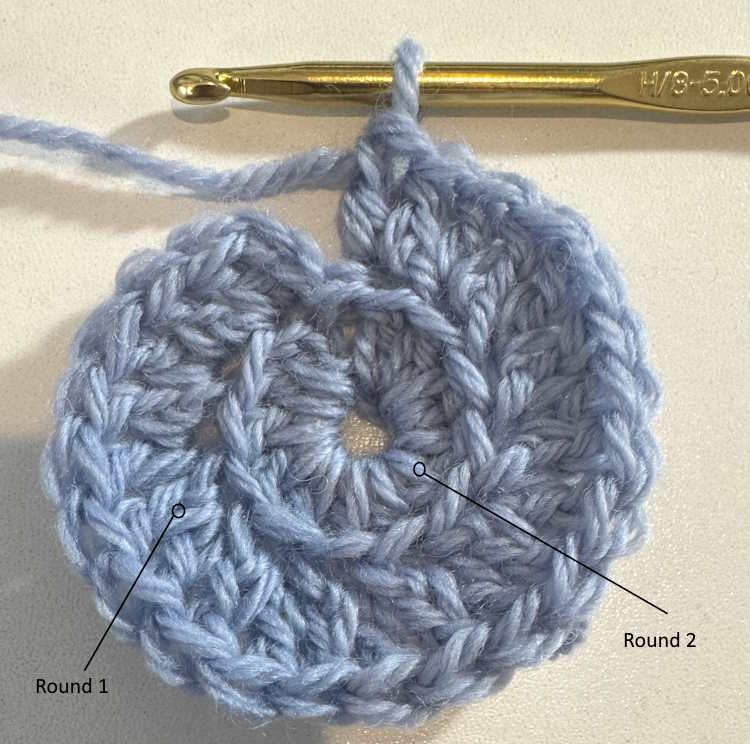 You can see each round easily on this swatch because I only worked in the back loop of the previous round. You may or may not want to do this in your own project.
You can see each round easily on this swatch because I only worked in the back loop of the previous round. You may or may not want to do this in your own project.Creating a Flat Round Crochet Circle
In my article about crocheting in the round, I outline a typical formula that you can use when trying to create a flat circle:
Round 1: (Often abbreviated Rnd 1) Crochet a certain amount of stitches into a magic circle or crochet several chains and connect with a slip knot to form a circle.
Rnd 2: Make two stitches in each stitch from the previous round
Rnd 3: Make two stitches in the first stitch, one stitch in the next, to you reach the end of the round,
Rnd 4: Make two stitches in the first stitch, one stitch in each of the next two stitches, and then continue in this manner until you reach the end of the round,
Rnd 5: Make two stitches in the first stitch, one stitch in each of the following three stitches, and continue like this until you reach the end of the round.
All subsequent rounds use this same formula, so round six would be as follows: Make two stitches in the first stitch, one in each of the following four stitches, and so forth.
Frequently Asked Questions
Does the slip knot count as a stitch?
Does the slip knot count as a stitch?
No, do not count that small knot at the beginning of your chain.
Do you count the loop on your hook as a stitch?
Do you count the loop on your hook as a stitch?
No. When you crochet, there will be a loop around the head of your hook. The loop of yarn on the hook doesn't count as a stitch or a chain.
Does the beginning chain count as a row?
Does the beginning chain count as a row?
No. When making the initial chain that you will work into afterward, the crochet stitches that you work into this initial chain (called foundation chain) do count.
Does the turning chain at the beginning of a row count as a stitch?
Does the turning chain at the beginning of a row count as a stitch?
This is where it gets confusing. For starters, there is somewhat of a convention about the number of turning chains one makes when beginning the row.
Single Crochet: Chain one at the beginning of the row (it Will not count as a stitch). Make your first single crochet into the first stitch from the previous row.
Half Double Crochet: Chain two at the beginning of the row.
Double Crochet: Chain three at the beginning of the row. (Will count as a stitch) Make your first double crochet into the second stitch from the hook. Make your last stitch at the end of each row into the top chain from the chain three from the previous row.
Treble Crochet: Chain four at the beginning of the row.
These same guidelines work whether you are working rows or rounds. However, this is the big caveat: follow the pattern because the designer has indicated how many chains to make. As you get more experienced, you may decide how many chains work best for your tension and style.
How to Count Crochet Stitches: Pin for Future Reference
How to Count Crochet Stitches: Conclusion
Counting stitches and rows in crochet is a key aspect that ensures your project preserves its intended shape and maintains a consistent design.
Miscounts can lead to disproportionate projects or an imbalance in the pattern. Understanding the different types of stitches, from the most basic chain stitch to single, double, and triple crochets, is fundamental for accurate counting. Techniques for counting crochet stitches include counting Vs at the top of the row or stitch posts.
Equally crucial is the ability to count rows in crochet. Tools like row counters and stitch markers can be extremely helpful in keeping track of your rows.
Counting stitches and rows in the round follows similar principles but requires extra care due to the presence of increases necessary to maintain a flat circle.
Mastering stitches and row-counting ultimately comes from practice and understanding the anatomy of different stitches.
It may seem challenging at first, but eventually, counting stitches and rows can become instinctive and second nature, lifting your crochet projects to a new level of professionalism and accuracy.
Remember that every skilled crocheter starts with the basics, and with patience and practice, you can do it, too.
